The history of the Seiko Lord Marvel is fascinating, as it lies at the heart of the evolution of post-war Japanese watchmaking. Launched in the late 1950s, it represented Seiko’s ambition to compete with Swiss houses in the luxury watchmaking field. What makes this watch so charming is its dual status: both an unknown ancestor of the prestigious Grand Seiko and the first high-frequency Japanese watch.
The Lord Marvel, first and foremost, boasts a sober and elegant aesthetic – a clean design, meticulous finishes, contained dimensions (35-36mm) – typical of dress watches from the 1960s. But above all, it represents a major technical advancement: its 1967 caliber 5740C, beating at 36,000 vibrations per hour, laid the foundation for the brand’s future Hi-Beat movements.
What makes this watch particularly interesting today is its exceptional value for money in the vintage world. Priced between €200 and €600 depending on the condition and version, it offers the quality level of a Swiss watch several times more expensive. As sometimes said on specialized forums, the Lord Marvel is « the Grand Seiko for the modest connoisseur »: a watch that has everything of a great one, except the price.
The Seiko Lord Marvel is a legendary wristwatch in Japanese watchmaking history. Launched in the late 1950s, it was Seiko’s first luxury watch and even the first Japanese high-frequency watch. An unknown ancestor of the Grand Seiko, it introduced major technical advancements while remaining relatively accessible to collectors today. In this article, we explore its history in detail, its iconic variants, the technical aspects of its caliber 5740 movement (A/B/C), an analysis of the » 36000 » model (ref. 5740-8000), as well as a buying guide with authentication tips, not forgetting a point on the current market and the potential valuation of this exceptional piece.
Sommaire
History and Genesis of the Lord Marvel
The story begins with Seiko’s desire to compete with Swiss watchmaking starting in the 1950s. In 1956, Seiko launched the Seiko Marvel, the first watch entirely designed in-house, featuring a central second hand instead of a small sub-second hand – a novelty for the brand.

This reliable and precise model laid the groundwork for future successes. Two years later, in 1958, Seiko introduced the Lord Marvel, a luxurious evolution of the Marvel, which became the brand’s top-of-the-line model. Produced by the Suwa factory, it positioned itself as the most accomplished Japanese watch of its time, with an improved 23-jewel movement and superior finishes. The first-generation Lord Marvel (caliber ref. Cal. Majesta 560 according to some internal sources) was offered in steel, gold-filled, and even 18-karat gold, proof of its decidedly luxurious positioning. For comparison, its price reached ¥26,000 in 1960 for the 18K gold version, a level equivalent to the first Grand Seiko launched later in 1960 (¥25,000). Despite its excellence, the Lord Marvel would quickly cede its flagship status to a newcomer: the Grand Seiko of 1960.
Indeed, in December 1960, Seiko introduced the Grand Seiko » First » (ref. 3180), a certified chronometer, which inaugurated a new, even higher-end range. The Lord Marvel, however, continued to be produced in parallel, affirming Seiko’s expertise. Moreover, the Lord Marvel is older than the King Seiko and Grand Seiko – its first model dates from 1958, two years before the first GS. It can therefore be considered the direct ancestor of Seiko’s prestigious lines. After a few years, Seiko would thoroughly evolve the Lord Marvel in the mid-1960s.
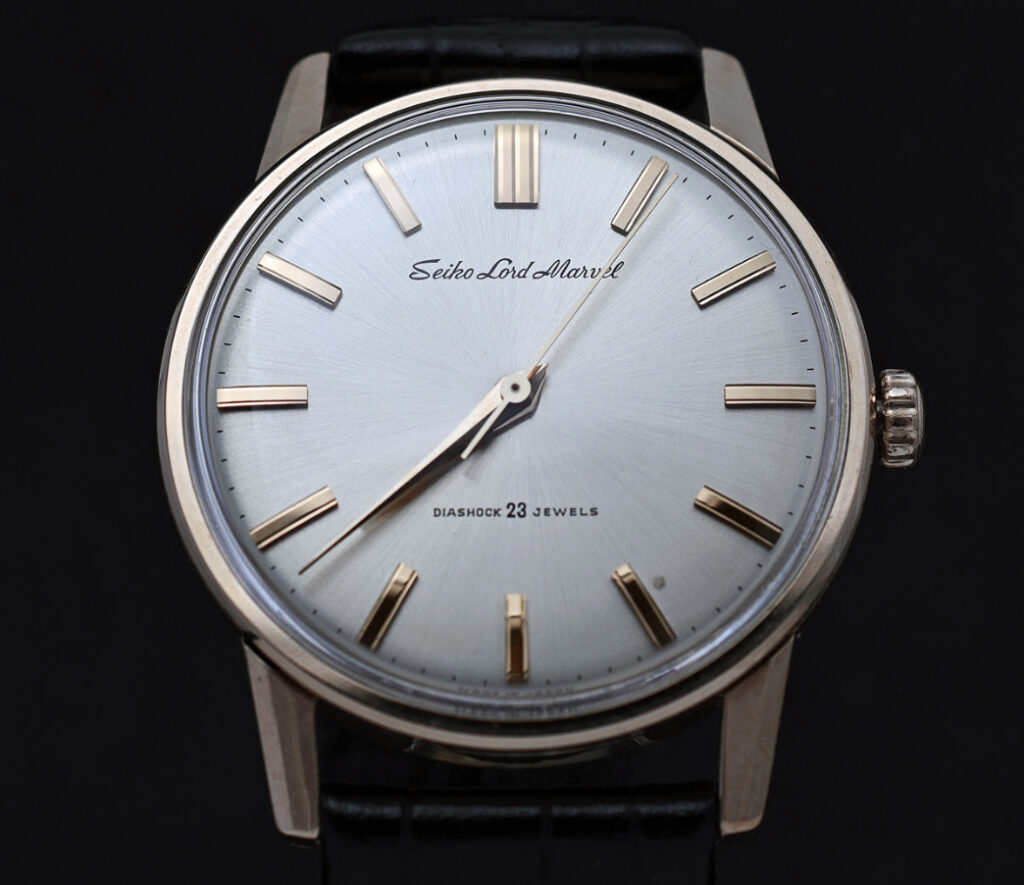
In 1964, the Lord Marvel was relaunched with a new 23-jewel caliber 5740, marking the Lord Marvel’s entry into the high-frequency era. This new generation of Lord Marvel first appeared with caliber 5740A in 1964, beating at 18,000 vibrations per hour (i.e., 5 bps). It is this 1964 model (reference 5740-1990) that is often considered the emblematic Lord Marvel, as it is the first mechanical » luxury » Seiko produced after the launch of the GS and KS – although it predates them in conception. Also in 1964, Seiko improved the movement by introducing caliber 5740B, increasing the frequency to 19,800 vph (5.5 bps) while retaining the 23 jewels. This version equipped, for example, the Lord Marvel reference 5740-0010 which appeared in late 1964 – sometimes called « Version 2″ by collectors – recognizable by its » Seiko » logo in cursive script on the dial and its case back engraved with the famous Seiko seahorse (present on some export examples).

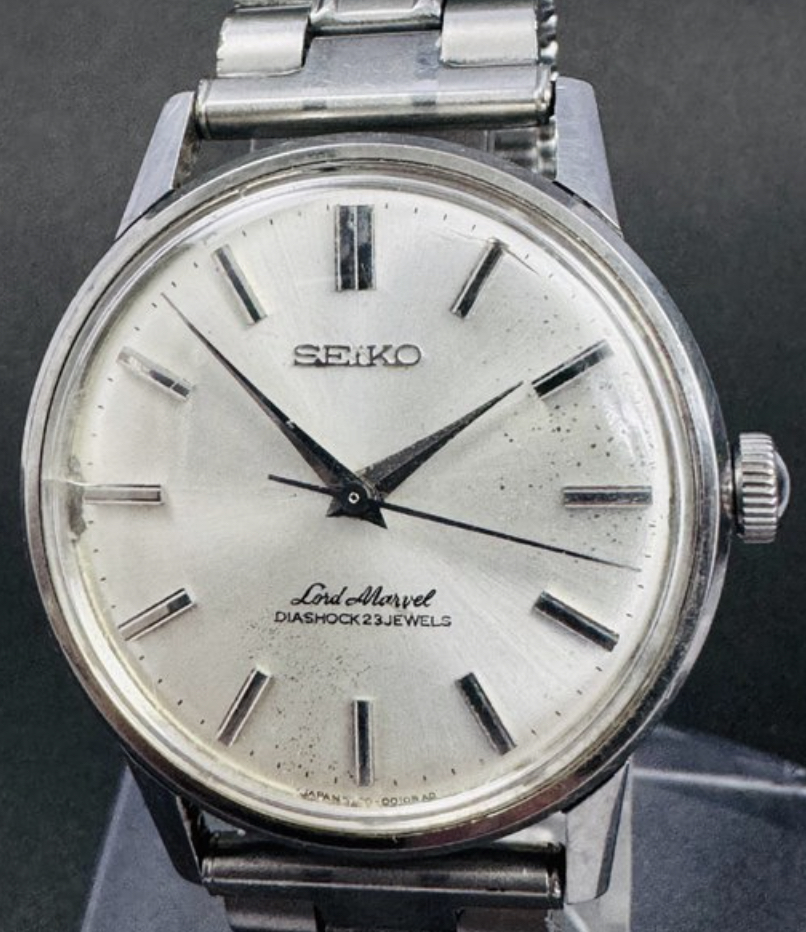
The most significant innovation occurred in 1967 with the introduction of the Lord Marvel known as » 36000 » equipped with caliber 5740C. As its nickname suggests, this movement increased the frequency to 36,000 vibrations/hour (i.e., 10 balance beats per second). This was a major breakthrough: the Lord Marvel 5740C (ref. 5740-8000) thus became the first Japanese high-frequency watch – and only the second in the world, a few months after the Girard-Perregaux Gyromatic 32A of 1966. This third-generation model, launched in late 1967, is commonly called the Lord Marvel 36000 due to this characteristic. It was produced until the late 1970s (remaining available in Japan even after its withdrawal from international markets). The Lord Marvel 36000 represents the pinnacle of the Lord Marvel line, combining high chronometric frequency with classic elegance. After its discontinuation, Seiko ceased the Lord Marvel family in favor of other ranges (such as the Seiko Lord Matic or Lordmatic Special in the 1970s, and of course the Grand Seiko and King Seiko for the high-end mechanical segment).
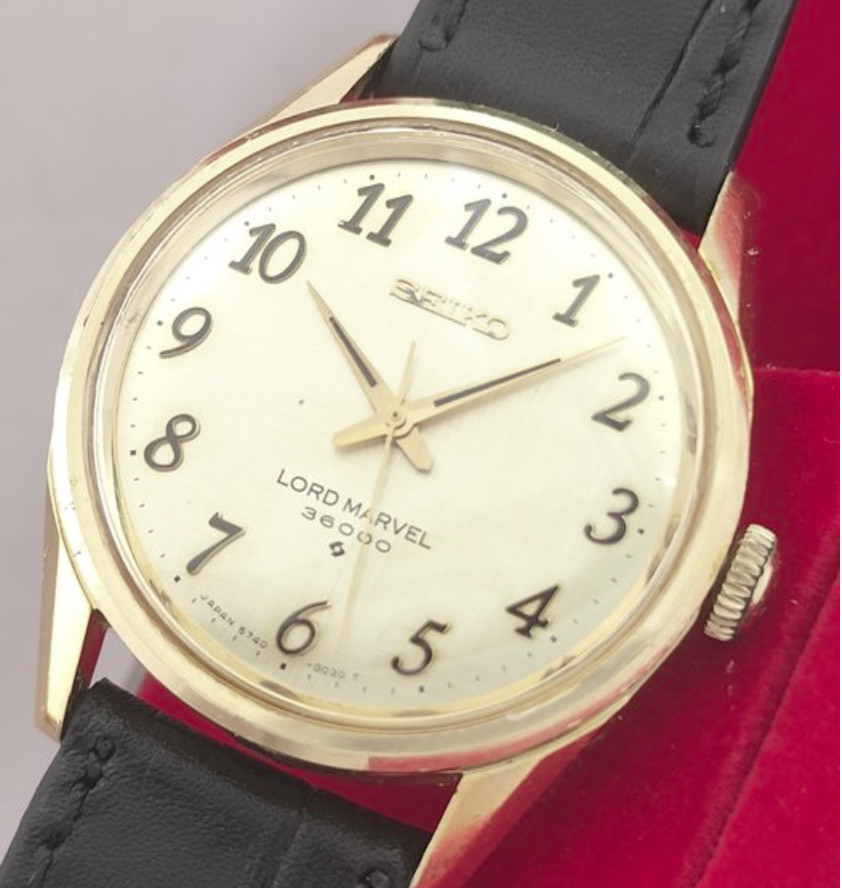
Iconic Variants and Aesthetic Evolutions
Throughout this history, several iconic variants of the Lord Marvel stand out:
The First Generations (1958-1963): The original Lord Marvels from the late 50s are characterized by a sober dial with an engraved (not printed on the very first examples) » Seiko Lord Marvel » logo, simple indices, and dauphine hands. They house a movement derived from the Marvel caliber 560 (revised to 23 jewels) and are housed in 35mm cases available in steel, gold-plated, or solid gold. These early series, now rare, often feature a screw-down case back stamped with the Seiko logo of the time (a stylized « S ») or the inscription « Waterproof ». They lay the aesthetic foundations (dial purity, faceted indices) for later models.
The 5740A/B Series (1964-1966): With the new 5740 caliber, the Lord Marvel underwent some notable evolutions. The case maintained a diameter of about 35-36mm, but the design was slightly modernized: the lugs could become slimmer, and the dial often featured the mention « Diashock 23 Jewels » (specific to Seiko shock-resistant watches) above 6 o’clock. On the very first 5740-1990 models from 1964 (cal. 5740A), the « Seiko Lord Marvel » logo remained in elegant cursive script. Later, on the 5740-0010 models (cal. 5740B, ~1965-66), the Lord Marvel logo was generally printed in classic English letters, with the word « Seiko » adopting either cursive or the block SEIKO font depending on the production year. The case back of these models is engraved with a circular text (often called a « horseshoe back » by collectors due to its shape) mentioning Seiko, the material (stainless steel), the 5740- reference, and the original water resistance (Waterproof). Some 1964 examples feature the engraved seahorse logo (Seahorse) in the center, the symbol of Seiko’s waterproof watches of the era – these « Seahorse » case backs are particularly sought after.
The 36000 Hi-Beat Model (1967-1975): The third-generation Lord Marvel (ref. 5740-8000) brought a visible change to the dial: the addition of the inscription « 36000 » just below the Lord Marvel logo. This proud mention highlights the high frequency of the movement. The indices remained the faceted « baton » type, often two-toned (polished exterior, black striped center) to enhance legibility, and the Suwa factory logo (a small S at 6 o’clock) still figured on the dial. There is no date window, so the design remains very pure and symmetrical, which dress watch enthusiasts appreciate. Seiko produced this model in both steel (soberly brushed back) and gold-plated, with several dial variations: the most common is silvered with a sunburst finish, but linen-textured dials (fine crosshatching evoking linen) with applied Arabic numerals (see photo above), or even golden dials, can also be found. The back of the Lord Marvel 36000 always bears the circular text (with the mention 5740-8000). Depending on the market, a letter is observed next to the word Japan on the back: for example, « Japan A » on export models and « Japan J » on exclusively Japanese models (JDM). This difference can help authenticate the origin of a watch (we will come back to this). It should be noted that the very first examples from 1967 still featured the seahorse logo on the back, but most only bear the circular inscription.
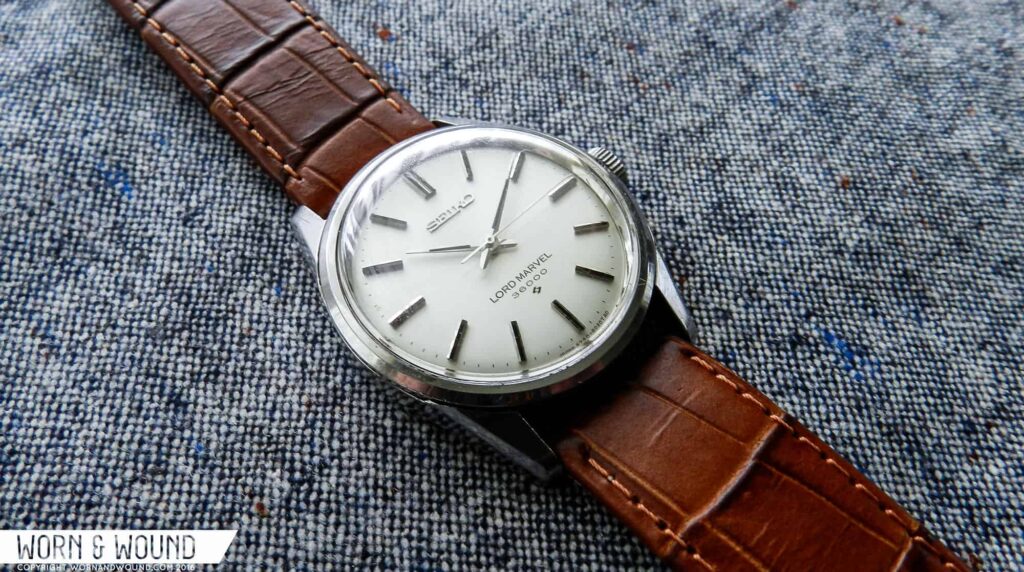
The 5740 Caliber: Technique and Evolutions (A, B, C)
The heart of the Lord Marvel is its manual-winding mechanical movement, the caliber 5740 developed by Suwa. This 11½ ligne caliber partly derives from the architecture of the 1956 Seiko Marvel, but it was greatly improved for the Lord Marvel. It benefits from an increased number of jewels (23 jewels compared to 17 previously), notably with the addition of cap-jewels (Diafix-type shock protection) on numerous pivots: center wheel, escape wheel, pallet fork, etc., on both the dial side and the gear train side. The balance bridge adopts a movable stud carrier (fine adjustment) instead of the fixed stud carrier of the old Marvel, improving the ease of regulating the rate. The finishing level is also superior, making the Lord Marvel a « world standard » product according to Seiko brochures of the time. The different versions of the caliber 5740 are as follows:
| Caliber | Introduction Year | Frequency | Jewels | Equipped Models |
|---|---|---|---|---|
| 5740A | 1964 | 18,000 vph (5 bps) | 23 | Lord Marvel 1st version (5740-1990) |
| 5740B | 1964 | 19,800 vph (5.5 bps) | 23 | Lord Marvel 2nd version (5740-0010) |
| 5740C | 1967 | 36,000 vph (10 bps) | 23 | Lord Marvel 36000 (5740-8000) |
As seen, Seiko doubled the balance frequency in just a few years, going from 5 to 10 beats per second. The 1967 caliber 5740C is thus the « grandfather » of Japanese hi-beat movements. Moreover, this 5740C would serve as the basis for the development of the caliber 44 that would equip the later King Seiko Chronometers: Seiko would not delay in applying high frequency to its other lines (in 1968, the Grand Seiko 45 and 61 Hi-Beat were released in turn). The 5740C remains nonetheless remarkable for its time, capable of improved accuracy thanks to its high frequency – which we will discuss again.
In terms of construction, the 5740 is a seemingly simple movement (direct central second, no date complication) but robust. It features a hacking seconds function on some versions (mentioned, for example, in the description of the 5740-1990), although not all examples seem to have it activated or it depends on the setting. The mainspring, housed in an unbridled barrel, offers a power reserve of about 45 hours on the 5740C despite the increased frequency – an honorable performance made possible by friction control and good lubrication.
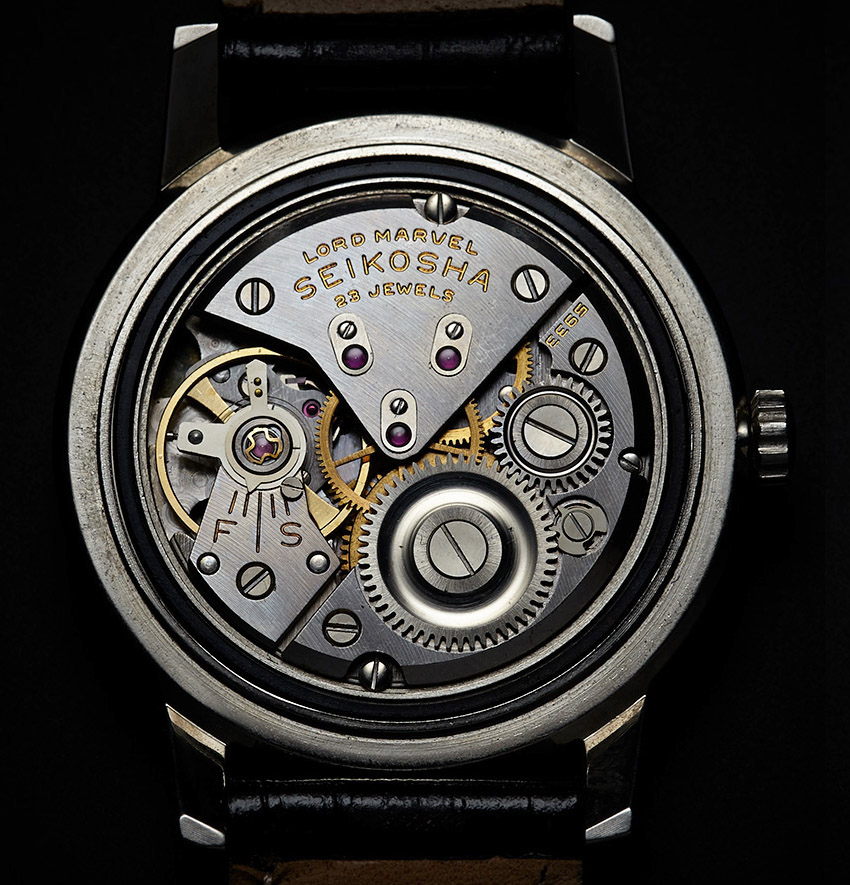
In terms of performance, each evolution of the 5740 caliber brought its share of improvements. The move to 36,000 vph, in particular, improved theoretical accuracy (a higher frequency better « averages out » rate errors). Seiko demonstrated the quality of this movement as early as 1968, ranking very honorably in the chronometer competitions of Neuchâtel and Geneva with movements based on the 5740C – just before the arrival of quartz ended these contests. When well-regulated, a 5740C caliber can easily maintain an accuracy of around +/-5 seconds per day, and even better. For example, a fully serviced example showed a 0 s/d drift and an amplitude of 167° on a timing machine after 60 hours of operation – an exceptional performance for a vintage mechanical watch, rivaling modern chronometers.
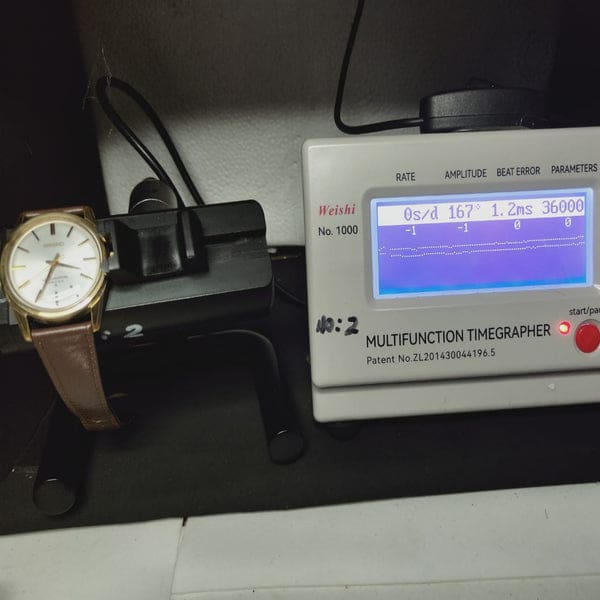
Focus: The Lord Marvel » 36000 » (Hi-Beat)
The Lord Marvel 36000 model (reference 5740-8000) deserves special attention, as it represents the culmination of this lineage and a technical milestone. Released in late 1967, it is the result of all the improvements made since the 1950s. Aesthetically, the Lord Marvel 36000 is a resolutely classic and elegant watch. Its stainless steel case measures approximately 35mm in diameter (42mm lug-to-lug), with a thickness of about 10.5mm – typical proportions for 60s dress watches, suitable for both a discreet male wrist and a modern female wrist. The case finish alternates between polished and brushed surfaces, and the tapered lugs have sharp edges (beware of improper polishing that could round them – a common flaw on old watches). The unsigned crown is quite large (almost 6mm) to facilitate daily manual winding. The dial of the Lord Marvel 36000 embodies the clean aesthetic dear to Seiko. Usually silver-toned with a satin finish (with subtle « sunburst » reflections under light), it features applied faceted baton indices, underlined with a black line in the center to improve visual contrast. Only the 12 o’clock index is double. At noon, the SEIKO logo is applied in polished metal, while at 6 o’clock, the printed text Lord Marvel followed by 36000 is found, just above the small Suwa symbol (S). The complete absence of a date window contributes to the symmetry and purity of the design. The hands are dauphine style in polished steel with a dark infill in the center (to match the indices and facilitate reading the hands on the light dial). Finally, a domed acrylic crystal covers everything, providing a warm vintage look (and easy to polish in case of scratches).
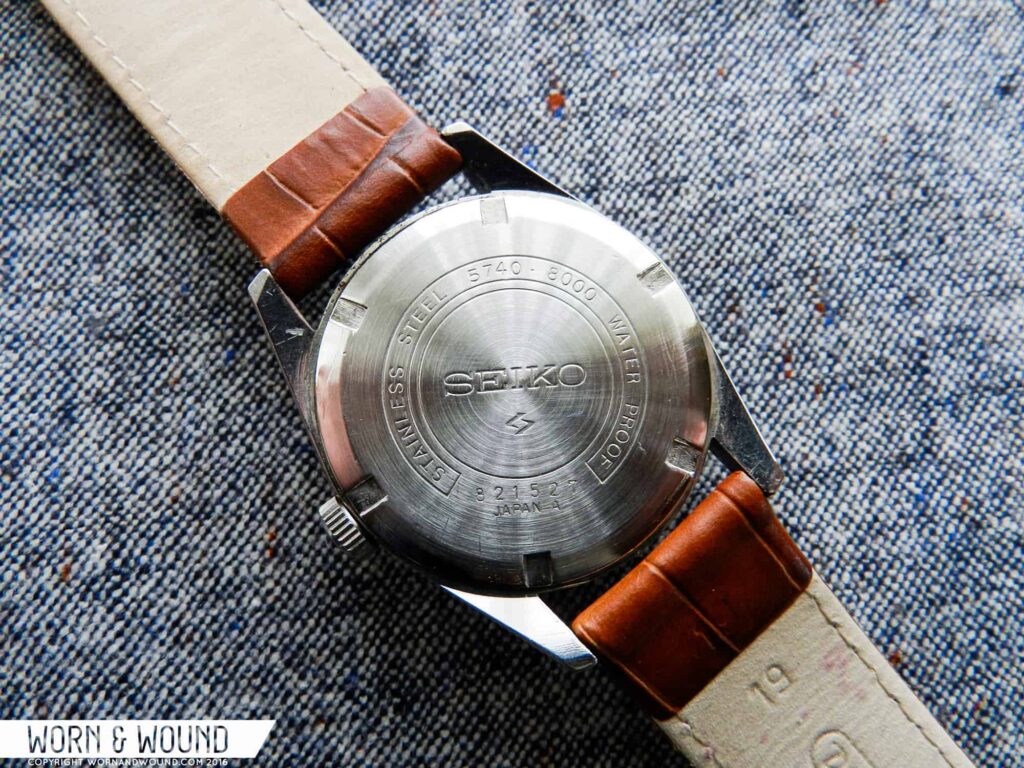
On the wrist, the Lord Marvel 36000 exudes a much-appreciated vintage presence. Its contained size and relatively flat profile allow it to easily slip under a shirt cuff. It is worn on leather (Seiko delivered it at the time on a leather strap without a deployant clasp) and no original version with an integrated steel bracelet is known, reinforcing its identity as a dress watch. As seen in the photos, it has a discreet elegance; its qualities are discovered in the details of the finishes and the harmony of its design.
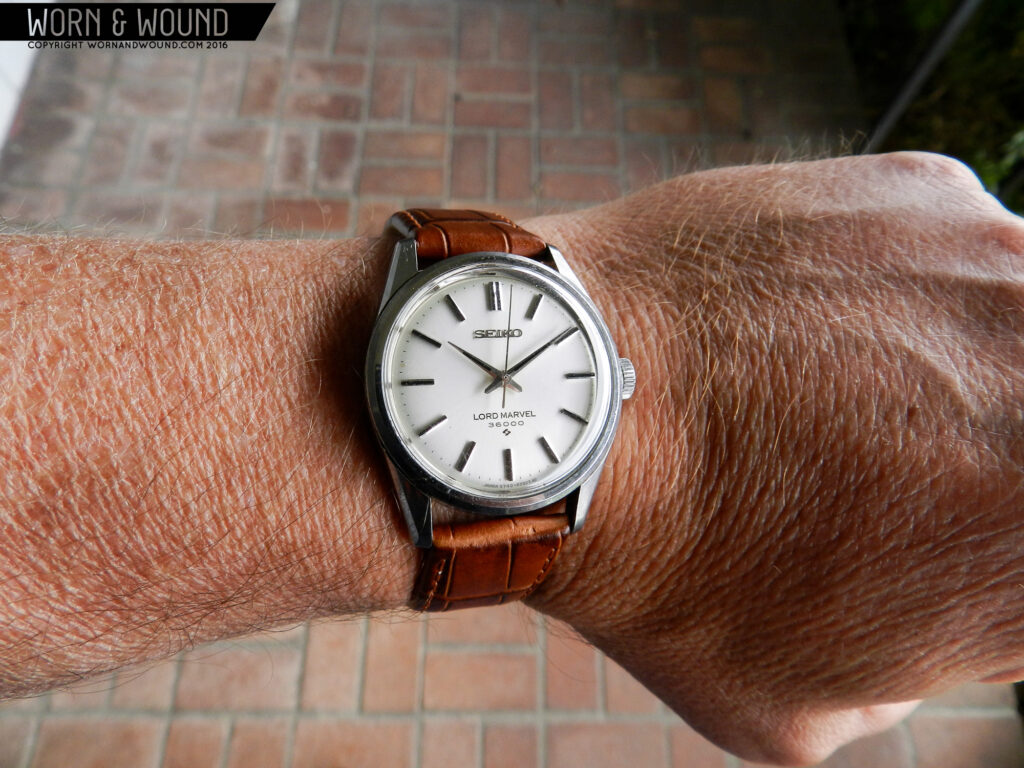
From a technical standpoint, we have highlighted the advancements of the 5740C caliber. It should be added that the Lord Marvel 36000 served as a testbed for Seiko for high frequency before equipping its Grand and King Seiko models with it. Thus, the 5740C caliber of the Lord Marvel is the direct precursor to the 44 caliber of the King Seiko Chronometers released in 1968. In a way, Seiko preferred to test its new technology in the Lord Marvel (likely for reasons of lesser commercial stake compared to the Grand Seikos) before integrating it into its entire high-end range. The success of this approach is undeniable, as the Lord Marvel 36000 laid the foundations for the brand’s future Hi-Beat movements. In summary, the Lord Marvel 36000 represents an achievement: it is the watch that, in 1967, placed Seiko among the world leaders in high frequency, alongside the Swiss. It remains today a highly appreciated model among connoisseurs, combining historical value (first Japanese Hi-Beat) and watchmaking qualities (precision, reliability, beauty of the visible movement for the curious who remove the case back). Some even consider it a « Grand Seiko that doesn’t speak its name, » so high was its level of finish and performance for the time.
Buying Guide: Checks and Authentication Tips
Buying a vintage Seiko Lord Marvel can be a rewarding experience if one takes a few precautions. Here are our tips for choosing an authentic example in good condition:
Identify the Version: First, determine which variant it is (first generation late 50s, caliber 5740A/B mid-60s, or hi-beat 5740C late 60s). This is done by reading the inscriptions on the dial and case back. For example, the presence of « 36000 » on the dial unambiguously indicates a 5740C caliber. Similarly, a case back bearing 5740-8000 refers to the hi-beat model, while a 5740-1990 reference indicates an earlier 1964 model. Ensure that the dial, case, and movement correspond correctly (an unscrupulous seller might, for example, put a « 36000 » dial on a slower movement – a rare case, but better to check). The caliber number is engraved on the movement plate itself (5740A/B/C) and can be checked by opening the case back if in doubt.
Examine the Dial: The vast majority of Lord Marvels on the market have their original dial, as Seiko used quality lacquers. Nevertheless, inspect the inscriptions: the Seiko Lord Marvel text should be fine and sharp, the printing of the word 36000 (if present) well-aligned and of the same hue. Beware of crudely repainted dials (typically, overly thick font or smudges). Also, check the indices: are they well-fixed, without suspicious glue marks? Gilt indices should match the color of the hands (also gilt) on gold-plated versions, or be steel on steel versions. Dauphine hands should have one polished face and the other possibly painted black (on Hi-Beats in particular); if they are entirely chromed without contrast, they may have been replaced or wrongly polished.
Case and Case Back: The case must correspond to the model and era. For example, the first Lord Marvels (1950s) often had a three-piece « coin » case, while the 1964+ versions have a flat screw-down back. Check the case back markings: a genuine Lord Marvel back will bear the correct reference (e.g., 5740-8000) and a 7-digit serial number. This serial number is valuable because it dates the watch (the first digit = the year of the decade, the second = the month). For example, a number starting with 95xxxxx on a 5740-8000 back corresponds to September 1969. Use this rule to see if the period matches the announced caliber/model. Furthermore, the presence of a letter after JAPAN (usually A or J) informs you about the origin: JAPAN J confirms a JDM (Japan Domestic Market) version, while JAPAN A or the absence of a letter often indicates an export version. This does not impact the quality, but this detail must be consistent with the dial: a dial without the Suwa S symbol and a Japan A back are typical of an export, whereas a dial with S and a Japan J back signals a true JDM. If you see an improbable mix (e.g., S dial but A back), further investigation is needed (sometimes, only the back was replaced during a repair).
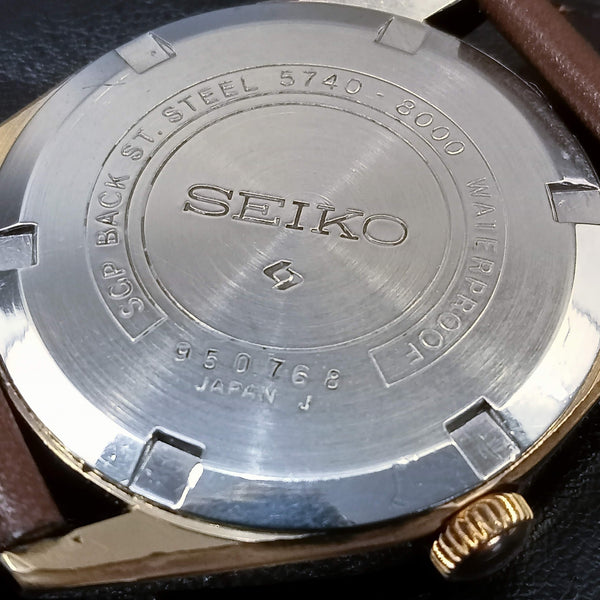
Movement Condition: It is rare to find fake vintage Seiko movements; the risk rather comes from a damaged or incompletely original caliber. Fortunately, the design of the 5740 is such that it is little modified compared to its variants: a 5740C looks the same as a 5740A to the naked eye, apart from the finer regulator and a few details. Ask the seller for a photo of the movement if possible. You should see the inscription « Seiko 23 Jewels » and ideally the engraved code 5740A/B/C. If the movement looks rusty, is missing screws, or if the balance is inert, factor the cost of a complete overhaul into the purchase price. Conversely, if the seller provides proof of servicing (invoice, timegrapher test with good amplitude, etc.), it is a very valuable plus.
Original Parts: The Lord Marvel is not a highly-priced model, so there is little incentive to « frankenstein » it (mix parts from various models). However, remain attentive to the originality of the components. The dial and case are numbered together (a 5740-8000 dial bears a reference ending in -8000T or -8000 SD at the bottom, for example). Ensure the crown is the correct type (it should be simple, unsigned, fairly wide). The plexiglass is not an issue if it has been changed (it is a consumable part), but the dial, hands, movement, and case should ideally all have left the factory together. A good indicator is aesthetic consistency and wear: for example, impeccable hands on a patinated dial may indicate a replacement. Ideally, opt for an « all original » example, even if it means a few micro-scratches, rather than a watch that looks too « new » and might have refinished parts. Serious professionals will specify if the watch is 100% original (excluding the strap).
Documentation and Accessories: As the Lord Marvel is a vintage piece, it is rare to find it with its original box or papers. This is not prohibitive, as it does not affect the watch itself, but it can add value for collectors. Do not be surprised that most are sold as watch heads only or with a modern box. Pay more attention to the mechanical and aesthetic condition.
In summary, take the time to inspect the provided photos carefully, do not hesitate to ask the seller specific questions (date of last service, timekeeping, etc.), and compare with the numerous online resources (forums, specialized sites) where enthusiasts share their experiences with the Lord Marvel. With a little patience and vigilance, you can find a very beautiful piece. For reference, know that the Lord Marvel was produced in thousands of examples: it is not a rare watch, and they regularly appear on sales sites. This abundance works in favor of buyers, as prices remain reasonable.
Value on the Current Market and Collection Potential
Despite its historical and technical importance, the Seiko Lord Marvel remains relatively affordable among collectible watches today. While Grand Seikos from the 60s – its more prestigious « cousins » – can reach very high prices (several thousand euros), a Lord Marvel generally trades in a range of €200 to €600 approximately, depending on the version and condition.
Specifically, models from 1958-1965 (calibers 560 or 5740A/B) in good condition are often found around €200-300. The Hi-Beat 36,000 versions tend to command slightly higher prices, typically €400 to €600 for a nice, unrestored steel example. For instance, a Lord Marvel 5740-8000 from 1968 in excellent original condition recently sold for €660. This is still well below the price of a Grand Seiko Hi-Beat from the same era (which would be worth 5 to 10 times more). Even in constant dollars, at its release, the Lord Marvel was worth the equivalent of a few hundred euros, and it can still be acquired today in that price range – a bargain considering its qualities.
As one observer wrote, « one might expect the Lord Marvel 5740-8000 to be expensive given its attributes… honestly, it should be. Yet one can easily find it in the $200 to $500 range depending on condition. » This situation is explained by the abundant supply (Seiko produced many, and numerous examples survive) and the fact that collector demand has long focused on Grand/King Seiko. However, there has been a growing interest in these « alternative » vintage Seikos in recent years. The Lord Marvel, particularly the 36000 model, is gaining recognition among enthusiasts for its status as the first Japanese hi-beat. Its value could therefore gradually increase in the future, especially for examples in near-new condition or with interesting provenance. Already, examples fully serviced by specialists sell for significantly more: prices around €600-800 have been seen from professional dealers for guaranteed and serviced Lord Marvel 36000s. This remains reasonable but indicates a slight upward trend in valuation.
Conclusion
For the buyer-collector, the Lord Marvel therefore offers exceptional value for money in the world of vintage watchmaking. You get a watch with a high-quality movement (legendary Japanese reliability, potentially excellent accuracy), timeless design, and undeniable historical pedigree – all for a fraction of the cost of an Omega or Rolex from the same period. Furthermore, its relative anonymity makes it a discreet piece: only insiders will recognize a Lord Marvel on the wrist at first glance, which can add to the pleasure of wearing it.
In terms of potential, the Lord Marvel can be seen as a « sleeping beauty » whose value could emerge from the shadows if the current trend for vintage Seikos continues. Without reaching peaks, it is not impossible that the best examples will double in price in the next 10 years. Regardless, buying a Lord Marvel should primarily be a watchmaking passion purchase: it is the ideal watch for those who want to enter the world of collectible Seikos without breaking the bank, while owning a true piece of technical heritage. As sometimes said on forums, the Lord Marvel is « the Grand Seiko for the modest connoisseur »: a watch that has everything of a great one, except the price. In this sense, it honors its name « Marvel » more than ever – a watchmaking marvel to (re)discover without moderation.


